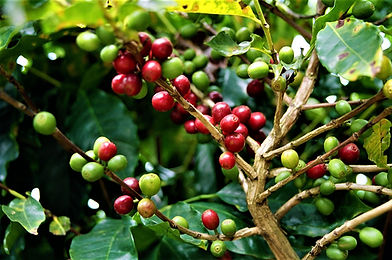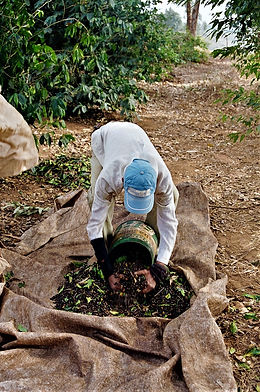CAFÉ 1 - Leaves of a coffee tree, with it´s first flowers
CAFÉ 3 - Flowers of a coffee tree
CAFÉ 5 - Coffee beans
CAFÉ 7 - Coffee harvest
CAFÉ 2 - A typical coffee farm at Minas Gerais slopes (Brazil)
CAFÉ 4 - Flowers of a coffee tree
CAFÉ 6 - Coffee harvest
CAFÉ 8 - Coffee harvest
CAFÉ 10 - Coffee harvest
CAFÉ 9 - Coffee harvest
CAFÉ 11 - Coffee harvest
CAFÉ 13 - Coffee harvest
CAFÉ 15 - Coffee beans going thru the washing process
CAFÉ 17 - Coffee beans under the Sun to be dried
CAFÉ 12 - Coffee harvest
CAFÉ 14 - Coffee harvest
CAFÉ 16 - Coffee beans under the Sun to be dried
CAFÉ 18 - Coffee beans are turned over to be dried uniformly
You sit in a coffee shop in your city and order an espresso or a filtered coffee. In a few minutes it will reach you. The first impact is in the presentation. Nowadays, good coffee shops focus on the way they serve, on the experience of a good coffee, using special cups or glasses, made of well-crafted crockery or ceramics, making the drink a special experience.
You hold the cup and place it in front of your eyes. Watch the thick foam, feel the heat, the smoke that dances in the air. Those aromas invade your nose and awaken sensations of pleasure, affective memories. You close your eyes and take the first sip. Your mouth is filled with that unmistakable flavor that brings notes of chocolate, almonds and fruits. Your senses will decipher these nuances and you will be connected to an ancient culture, which dates back to the first records of coffee culture in the 6th Century AD and which invaded Europe much later, in the 14th Century AD.
But when you are drinking a cup of coffee, such a very common and daily act, you never reflect on its origins, on the work necessary for it to reach you, on the effort of many workers in their fields, roasters, traders, nor on the risk taken by those who invest in agriculture, always exposed to the adversities of the climate and of the commodities market.
With these photos I want you to know a little behind the scenes of this cup of coffee, the effort required for these beans to be harvested and sent to the market, so that they can then be roasted, ground, and from their powder extracted one of the most consumed beverages in the world.
Life happens in cycles - the stages of maturation, from conception and birth, through growth to maturity. That's how living beings are. And everyone is submitted to the cycles of nature, with the succession of days and nights, with the seasons, the phases of the moon, the tides going high or low... Everything has a beginning, an unfolding and a conclusion, and then restart.
So too is agriculture, which is nothing more than knowing, mastering and caring for plants, observing their cycles, potentialities and limitations, in order to extract the best from them in terms of nutrients and flavor. Knowing and respecting these cycles is an art, brought in our cultural baggage with thousands of years, for countless generations, and it is what allows our evolution and subsistence.
The coffee culture, as part of this agriculture, is also submitted to the cycles of nature. To observe this culture is to appreciate the opening of flowers, the formation of the fruits, their maturation, the producer's anxiety about the rains that sometimes have to fall, sometimes need to give a truce, the joy of the harvest and the hope that it will be plentiful, and the processing of the grains so that they are offered to the market.
In an urban and technological society that educates itself for the speed of processes, for an accelerated pace of life, where everything can be accessed and obtained in a click, agricultural crops require patience, caution, they ask for calm and submission to the rhythms and cycles of nature, which is in charge of everything around here. There is no harvest without the fruits ripening; there are no fruits without the beauty of flowers; there are no flowers if the weather doesn't allow it; plants cannot grow without the hard and attentive work of these workers, men and women, in planting and caring for the soil.
Agricultural crops, such as coffee, have been modernized over time. Today, many biological, genetic and data processing technologies are being incorporated into crops, but nothing will replace the need to wait for the natural cycles of plants, of pests and of the climate. In short, man tries to control as many variables as possible by adopting the most modern technologies, but nature remains the absolute master in the fields, from the beginning to the end of history.
This Gallery of images presenting the coffee culture covers the period of almost a year, from the blooming with the first flowers opening, the ripening of the fruits on the trees, the arduous work of harvesting and drying the beans in the yards. The result of each harvest is always a surprise, so being in these crucial moments of the crop is feeling the energy of so much work involved, the anxiety and faith of the producers for a positive result and the eternal cheering for the weather to be favorable.
It takes months of hard work so that the final result is a quality product that meets the expectations of the demanding consumer market. The routine of these workers always starts very early in the morning, with the sun still rising, and goes on until late afternoon. There are long hours of work under the heat of the Sun and facing the roughness of the plants, the dust of the ground, dodging snakes and with a lot of physical effort. But despite the age of these workers and the harshness of the work, joy is on everyone's face. The pleasure of being in a group and the conversations and laughter with fellow workers lighten the weight of the coffee bags. The body suffers, but the mind flies.
With skill and with calloused hands, the coffee pickers walk the streets of the coffee plantation, dropping the beans on canvas placed under the coffee trees. Then the leaves that fall along with the grains are removed, leaving on the canvas only the grains that are bagged and taken to the yard. There they are washed, a process that separates the ripest grains, and finally they are spread out on the terrace for the sun to do its drying work. In order for drying to take place uniformly, the beans are constantly turned by the careful passage of squeegees until they reach the ideal point.
The next time you order a cup of espresso coffee, or strain that coffee at home, smell it and remember the work required for this product to reach your table, knowing that many people put a lot of work into it and that nature played a key role in its development.
All images in this Gallery are available to be printed with FineArt quality, with special papers and inks. Contact us and request your budget.




















